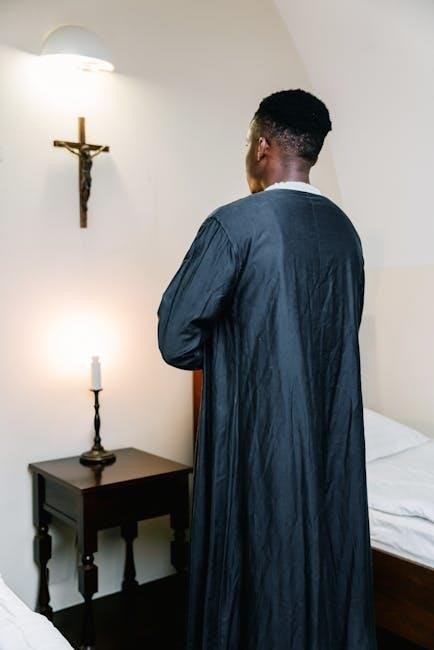The Bedtime Shema Prayer is a sacred Jewish tradition, offering spiritual protection, forgiveness, and reflective preparation for sleep, rooted in Talmudic teachings and promoting inner peace.
Significance of the Bedtime Shema in Jewish Tradition
The Bedtime Shema holds profound significance in Jewish tradition, serving as a declaration of faith and a means of seeking forgiveness before sleep. Rooted in Talmudic teachings, it reflects the commandment to recite the Shema when lying down, as stated in Deuteronomy 6:7. This prayer not only provides spiritual protection during the night but also fosters a connection with the divine, ensuring a restful and spiritually rejuvenating sleep. Its recitation is a universal Jewish practice, emphasizing faith, humility, and preparation for the unknown, making it a cornerstone of daily spiritual life.
Overview of the Bedtime Shema Prayer Content
The Bedtime Shema Prayer consists of several key components, beginning with introductory prayers seeking forgiveness and protection during sleep. It includes the central Shema prayer, affirming the oneness of God, and additional passages that focus on spiritual growth and divine protection. The prayer also incorporates requests for mercy, the alleviation of negative judgments, and the preparation of the soul for rest. These elements collectively create a comprehensive ritual that fosters spiritual reflection, protection, and connection with the divine, ensuring a peaceful and meaningful transition into sleep.
Purpose of Reciting the Shema Before Sleep
Reciting the Shema before sleep serves to foster a deep connection with the divine, seeking protection and forgiveness. It cleanses the soul, alleviates negative karma, and prepares the spirit for rest. This practice, rooted in Talmudic teachings, ensures spiritual safeguarding during the night, promoting peaceful sleep and positive dreams. By declaring faith and humility, individuals align themselves with divine will, creating a sacred transition into slumber and reinforcing their commitment to spiritual growth and mindfulness.

Historical Background of the Bedtime Shema
Originating in the Torah, the Shema prayer has evolved from its biblical roots through Talmudic discussions, becoming a central component of Jewish bedtime rituals for centuries.
Talmudic Origins of the Bedtime Shema
The Talmud in Berachot 60b discusses the obligation to recite the Shema before sleep, emphasizing its roots in Deuteronomy 6:7. The Sages highlighted its protective qualities, ensuring divine safeguard during the night. This practice, formalized in Talmudic times, underscores the Shema’s role in seeking forgiveness and spiritual preparation for the afterlife, should one pass away during sleep, making it a cornerstone of Jewish evening rituals for centuries.
Evolution of the Bedtime Shema Prayer Over Time
The Bedtime Shema Prayer has evolved from its Talmudic origins, with additions and interpretations by scholars like Rabbi Shneur Zalman of Liadi and the Arizal. Over centuries, the prayer incorporated elements like forgiveness requests and divine protection, reflecting deeper spiritual dimensions. Modern adaptations include translations and digital resources, making it accessible to diverse audiences while preserving its core purpose of seeking forgiveness, protection, and spiritual rest, ensuring its relevance across generations and cultural shifts.
Key Figures in Shaping the Bedtime Shema Tradition
Rabbi Shneur Zalman of Liadi and the Arizal were pivotal in shaping the Bedtime Shema tradition. Their teachings emphasized the prayer’s spiritual significance, incorporating elements like forgiveness and divine protection. Rabbi Shneur Zalman’s structured approach ensured the prayer’s accessibility, while the Arizal’s mystical insights deepened its spiritual impact. Their contributions have been passed down through generations, influencing modern adaptations and ensuring the prayer’s enduring relevance in Jewish practice, as reflected in the PDF resources available today.

Structure of the Bedtime Shema Prayer
The Bedtime Shema Prayer includes core components like the Shema itself, introductory prayers for forgiveness, and requests for protection during sleep, emphasizing concentration and intention.
Core Components of the Bedtime Shema
The Bedtime Shema Prayer consists of three central parts: the Shema itself, the blessing for sleep, and prayers seeking forgiveness and protection. These elements are essential for spiritual rest and positive energy, emphasizing mindfulness and unity with the divine. The Shema reaffirms faith, while additional prayers address personal reflection and safeguarding the soul during slumber. Together, these components create a holistic practice that nurtures both body and spirit, fostering a tranquil and meaningful transition into sleep each night.
Introductory Prayers and Forgiveness Requests
The Bedtime Shema begins with introductory prayers that prepare the soul for recitation, seeking forgiveness and divine protection. These prayers include requests for pardon, reflecting on the day’s actions and clearing negative energies. Forgiveness is a central theme, fostering humility and inner peace. The introductory section also invokes divine mercy, ensuring a safe and spiritually uplifted sleep. This practice encourages personal accountability and harmony, creating a sacred transition into rest and renewal, grounded in faith and mindfulness. The prayers are deeply personal, fostering a connection to the divine and oneself.
Concentration and Intention During Recitation
Concentration and intention are vital during the Bedtime Shema, ensuring its words resonate deeply. One must focus on the prayer’s meaning, particularly the declaration of faith in the unity of God. Proper focus enhances spiritual connection and protection. The Arizal emphasized meditative intention to elevate the soul and remove negative energies. This mindfulness ensures the prayer’s efficacy, fostering a meaningful and transformative experience. By aligning one’s heart and mind, the recitation becomes a powerful tool for spiritual growth and divine alignment, preparing the soul for rest and renewal.

Translations and Resources for the Bedtime Shema
The Bedtime Shema is available in PDF formats with Hebrew text, English translations, and interlinear transliterations. Resources include Kehot Publications and Hebrew4Christians, offering comprehensive guides for recitation and study.
Hebrew Text and Transliteration
The bedtime Shema prayer PDF provides the full Hebrew text, alongside an interlinear transliteration. This format aids those who may not read Hebrew fluently. The prayer includes the Shema itself, blessings for protection during sleep, and requests for forgiveness. It also contains additional passages such as Hareini Moḥel, the forgiveness prayer, ensuring a comprehensive experience. The transliterations follow traditional pronunciation guidelines, making it accessible for personal recitation or communal use. This resource is widely available from publishers like Kehot and Hebrew4Christians, ensuring accessibility for all.
English Translation of the Bedtime Shema
The English translation of the bedtime Shema prayer provides a clear and accessible rendition of the Hebrew text. It includes the core declaration, “Hear, O Israel, the Lord is our God, the Lord is One,” along with blessings for sleep and forgiveness. The translation maintains the spiritual essence of the original, ensuring that the prayer’s intent and meaning are preserved. This version is particularly useful for those who are not fluent in Hebrew, allowing for deeper connection and understanding during recitation.
Interlinear Transliteration for Easy Recitation
The interlinear transliteration of the bedtime Shema prayer provides a phonetic guide, making it accessible to those unfamiliar with Hebrew. Each Hebrew word is paired with its English pronunciation, ensuring accurate and meaningful recitation. This format is especially helpful for learners or non-native speakers, allowing them to connect deeply with the prayer’s spiritual essence. The transliteration is often included in Bedtime Shema PDF resources, enhancing ease of use for personal or communal recitation.

Benefits of Reciting the Bedtime Shema
Reciting the Shema before sleep offers spiritual protection, fosters forgiveness, and enhances rest, promoting positive dreams and spiritual growth, aligning one with divine energy and peace.
Spiritual Protection During Sleep
Reciting the Bedtime Shema offers profound spiritual protection during sleep, shielding from negative entities and harmful forces. It ensures a peaceful rest, aligning one with divine energy and fostering positive dreams. This ancient prayer, rooted in Talmudic traditions, creates a safeguard against spiritual harm, providing comfort and security; By invoking divine protection, it strengthens the soul’s connection to the Almighty, promoting tranquility and renewal. The Shema’s recitation is believed to repel negative influences, ensuring a safe and restorative sleep experience.
Forgiveness and Karma Alleviation
The Bedtime Shema includes prayers for forgiveness, seeking to alleviate karma and negative deeds. It encourages self-reflection and mercy, asking for pardon for past actions. This practice helps purify the soul, reducing spiritual judgment. By forgiving others and oneself, it promotes inner peace and harmony. The Shema’s recitation is believed to mitigate negative karma, offering a fresh start. This ritual fosters personal growth and renewal, aligning one with divine grace and compassion, ensuring a lighter spiritual burden and a clearer conscience.
Enhanced Spiritual Rest and Positive Dreams
Reciting the Bedtime Shema elevates spiritual rest, fostering a deeper connection with the divine. It cleanses the soul, promoting peaceful sleep and positive, insightful dreams. This prayer safeguards against negative influences, creating a protective environment. By aligning with divine energy, it ensures restorative rest, rejuvenating both body and spirit. The Shema’s power enhances mental clarity and emotional balance, leading to uplifting experiences during sleep, and preparing one for a spiritually enriched tomorrow.
Traditions and Customs Surrounding the Bedtime Shema
The Bedtime Shema is deeply rooted in Jewish tradition, emphasizing spiritual preparation for sleep. It includes prayers for forgiveness, divine protection, and aligning with sacred energies, fostering inner peace.
Traditions According to Rabbi Shneur Zalman of Liadi
Rabbi Shneur Zalman of Liadi, founder of Chabad, emphasized the Bedtime Shema as a profound spiritual practice. His traditions include reciting the full Shema text with proper concentration, along with a Forgiveness Prayer seeking pardon for others and oneself. He stressed the importance of introspection and aligning one’s actions with divine will before sleep. The prayer structure he recommended includes blessings for protection and forgiveness, fostering a deep connection to the divine. His customs are widely followed, promoting spiritual rest and positive dreams through mindful recitation.
Practices Recommended by the Arizal
The Arizal (Rabbi Isaac Luria) emphasized the transformative power of the Bedtime Shema, teaching that its recitation could eliminate negative entities and judgments. He recommended reciting the Shema with intense concentration and meditative focus, particularly on the divine names and their mystical significance. The Arizal also advised incorporating specific passages and prayers, such as the Hareni Moḥel (I hereby forgive) prayer, to seek forgiveness and cleanse the soul before sleep. His practices aim to enhance spiritual protection and foster a deeper connection to divine energy during rest.
Modern Customs and Adaptations
Modern customs have made the Bedtime Shema more accessible, with PDF versions offering Hebrew text, English translations, and transliterations. Many incorporate contemporary meditative practices, such as reflective journaling or mindful breathing, to deepen the prayer’s spiritual impact. Digital apps and online resources provide guided recitations, making it easier for individuals to maintain the tradition. Additionally, some communities have adopted inclusive language and creative visual aids to engage younger generations, ensuring the prayer remains relevant while preserving its ancient significance and mystical essence.

Using the Bedtime Shema Prayer PDF
The Bedtime Shema Prayer PDF provides accessible Hebrew text, English translations, and transliterations, making it easy to recite and understand. It is downloadable and printable, offering clear instructions for meaningful recitation and spiritual reflection before sleep.
Downloading and Accessing the PDF
The Bedtime Shema Prayer PDF is easily downloadable from reputable sources like the Kehot Publication Society. It features the full Hebrew text, English translations, and transliterations for easy recitation. The document is formatted for clear readability, with instructions for proper concentration and intention. Users can access it online or print it for personal use. This resource is ideal for both experienced practitioners and newcomers, ensuring a meaningful and spiritually enriching experience. Its availability in digital and physical formats makes it accessible for everyone.
Navigating the PDF Document
The Bedtime Shema Prayer PDF is structured for easy navigation, featuring clear sections and bookmarks. Users can quickly locate the Hebrew text, English translations, and transliterations. The document includes a table of contents for seamless browsing, allowing readers to jump to specific prayers or explanations. Key sections highlight the Shema prayer, introductory blessings, and forgiveness requests. The PDF is designed to be user-friendly, ensuring a smooth experience for both beginners and experienced practitioners.
Printing and Sharing the Bedtime Shema PDF
The Bedtime Shema PDF is designed to be easily printed on standard paper in portrait orientation. Users can adjust margins for optimal text layout. For sharing, the PDF can be emailed or printed for distribution in synagogues, schools, or homes. Many communities print it on decorative paper or add covers for a personalized touch. Sharing the document fosters spiritual connection and helps others adopt this meaningful practice, ensuring the tradition’s continuity and accessibility for all who seek to deepen their evening prayers.

Practical Meditations on the Bedtime Shema
Reflect on daily actions, seek forgiveness, and connect with divine energy before sleep, fostering spiritual rest and positive dreams through mindful recitation of the Shema prayer.
Reflecting on the Day’s Actions
Reflecting on the day’s actions is a key component of the Bedtime Shema prayer, encouraging introspection and accountability. This practice, rooted in Talmudic teachings, involves reviewing one’s deeds, acknowledging mistakes, and seeking forgiveness. By reciting specific prayers, individuals express regret for harm caused, whether intentionally or unintentionally, and ask for divine mercy. This reflection fosters emotional clarity, spiritual cleansing, and a deeper connection to one’s values. It also promotes gratitude for positive experiences, creating a mindset conducive to restful sleep and personal growth.
Seeking Forgiveness and Letting Go
Seeking forgiveness is a central aspect of the Bedtime Shema, fostering emotional and spiritual release. The prayer includes a heartfelt request for pardon, addressing wrongs committed against others or oneself. By reciting passages like “Hareni Moḥel” (I hereby forgive), individuals release grudges and negative emotions, cleansing the soul. This act of letting go promotes inner peace, allowing for a deeper connection to the divine and a restorative sleep; It also aligns with the tradition of spiritual cleansing before encountering the divine during rest.
Connecting with Divine Energy Before Sleep
Reciting the Bedtime Shema fosters a profound connection with divine energy, preparing the soul for spiritual elevation. The prayer emphasizes mindfulness and intention, aligning one’s consciousness with the divine. By declaring the Shema’s words, individuals affirm their belief in the oneness of God, creating a sacred space for rest. This practice, rooted in Talmudic and Kabbalistic teachings, is believed to offer protection from negative influences and promote positive spiritual renewal during sleep, ensuring a deeper, more restorative connection to the divine.

Cultural and Communal Aspects of the Bedtime Shema
The Bedtime Shema strengthens family bonds and communal unity, fostering a shared spiritual identity. Its recitation is often practiced collectively, emphasizing tradition and cultural heritage across generations.
Family and Community Recitation Practices
The Bedtime Shema is often recited collectively within families and communities, fostering a sense of unity and shared spiritual identity. Parents teach their children the prayer, ensuring its continuity across generations. Community gatherings may include group recitation, enhancing the collective spiritual experience. This practice strengthens familial bonds and reinforces cultural heritage, creating a meaningful tradition that connects individuals to their faith and community. It also serves as a moment for collective reflection and spiritual renewal before sleep.
Teaching the Bedtime Shema to Children
Teaching the Bedtime Shema to children is a cherished Jewish tradition, fostering spiritual growth and a connection to faith. Parents guide their children in reciting the prayer, emphasizing its significance for protection and peace during sleep. Resources like the Bedtime Shema Prayer PDF provide accessible tools for learning, with Hebrew text, transliteration, and translations. This practice instills a sense of duty and comfort, helping children develop a lifelong commitment to their heritage and spiritual well-being.
Interfaith and Cross-Cultural Perspectives
The Bedtime Shema Prayer resonates across cultures, offering universal themes of forgiveness, divine connection, and peace. Its emphasis on spiritual reflection and protection during sleep appeals to diverse faith traditions. Non-Jewish individuals often appreciate its structure and emotional depth, finding comfort in its universal message. The availability of the Bedtime Shema Prayer PDF in multiple languages and formats fosters accessibility, allowing people from various backgrounds to explore its significance. This shared practice bridges cultural gaps, encouraging mutual respect and understanding among different communities.

Differences Between Morning and Evening Shema
The morning Shema focuses on awakening and gratitude, while the evening Shema emphasizes spiritual protection and reflection. Unique aspects include forgiveness requests and divine protection during sleep.
Unique Aspects of the Evening Shema
The Evening Shema includes unique prayers for forgiveness and protection during sleep, such as the Angel Prayer and blessings for divine safeguarding; It emphasizes spiritual purification, reflecting on the day’s actions, and seeking pardon before rest. Unlike the morning Shema, the evening version incorporates specific requests for protection from negative entities and harmful spirits, aligning with the belief that sleep is a vulnerable state requiring divine shelter. This prayer also focuses on preparing the soul for rest and ensuring a peaceful transition into the night.
Comparative Analysis of Morning and Evening Prayers
The morning Shema focuses on awakening and gratitude, while the evening Shema emphasizes protection and forgiveness during sleep. The morning prayer includes blessings for the new day, while the evening prayer incorporates requests for divine safeguarding and spiritual purification. Both prayers highlight the Shema’s centrality but serve distinct spiritual needs, reflecting the transition from daytime activities to nighttime rest and preparation for the soul’s repose. This contrast underscores the balance between awakening and slumber in Jewish liturgical practice.
Transitioning from Day to Night with the Shema
Reciting the Shema at bedtime serves as a spiritual bridge from day to night, offering a moment of reflection and preparation for rest. It helps transition the mind from worldly concerns to divine connection, fostering a sense of closure and renewal. By reciting the Shema, one acknowledges the end of the day’s activities and seeks forgiveness, while also inviting spiritual protection during sleep. This practice ensures a peaceful transition, aligning the soul with divine energy as night falls, and preparing for the spiritual rest ahead. The Shema thus becomes a sacred ritual, marking life’s daily rhythm.

Modern Interpretations and Innovations
The Bedtime Shema Prayer now features contemporary translations and digital tools, enhancing accessibility and integrating timeless traditions into modern life through innovative resources like downloadable PDFs.
Contemporary Translations and Adaptations
Modern interpretations of the Bedtime Shema Prayer include translations by Rabbi Zalman Schachter-Shalomi, blending traditional and contemporary language. PDF resources now offer Hebrew, English, and interlinear transliterations, making the prayer accessible to diverse practitioners. Digital tools and apps provide guided recitations, enhancing engagement. These adaptations ensure the prayer remains relevant, while maintaining its spiritual depth and historical significance. Forgiveness prayers and reflective meditations are also included, fostering personal connection and modern relevance in daily practice.
Integrating the Bedtime Shema into Modern Life
The Bedtime Shema Prayer PDF offers a practical way to incorporate this sacred tradition into modern routines. By leveraging digital tools and apps, individuals can access guided recitations and reflective meditations, fostering mindfulness and consistency. The prayer’s emphasis on forgiveness and spiritual rest resonates deeply in today’s fast-paced world, providing a calming conclusion to the day. Its accessibility in PDF formats ensures it remains relevant, while its timeless message continues to inspire personal growth and connection to faith, even in contemporary life.
Technology and the Bedtime Shema Experience
Technology has transformed the Bedtime Shema experience, making it more accessible and engaging. Downloadable PDFs provide convenient access to the prayer text, while apps and digital platforms offer guided recitations and translations. Interactive tools enhance understanding, allowing users to explore the prayer’s deeper meanings. Additionally, digital resources often include meditations and reflections, helping individuals maintain consistency in their practice. This modern approach ensures the timeless tradition remains relevant, bridging ancient rituals with contemporary life for a meaningful and connected experience, no matter the time or place.
The Bedtime Shema Prayer remains a profound practice, offering spiritual protection, forgiveness, and deep connection. Its timeless wisdom bridges ancient traditions with modern accessibility, encouraging daily recitation for peace and harmony.
The Enduring Significance of the Bedtime Shema
The Bedtime Shema holds enduring significance as a sacred Jewish practice, offering spiritual protection, fostering forgiveness, and enhancing rest. Rooted in Talmudic origins, it bridges ancient traditions with modern life, providing a meaningful way to connect with divine energy before sleep. Its inclusion in daily rituals ensures a profound sense of peace and harmony, making it a timeless and essential component of Jewish spirituality and personal reflection.
Final Thoughts on the Bedtime Shema Prayer
The Bedtime Shema Prayer remains a deeply meaningful practice, bridging ancient traditions with modern spirituality. It offers a moment of reflection, forgiveness, and connection with the divine, fostering peace and protection during sleep. Its enduring relevance lies in its ability to adapt to contemporary life while preserving its sacred essence. Incorporating the Bedtime Shema into daily routines enriches spiritual life, providing a sense of harmony and renewal. Its availability in PDF formats ensures accessibility, making it a timeless and universal prayer for all.
Encouragement for Daily Recitation
Embrace the Bedtime Shema Prayer as a nightly ritual to enrich your spiritual life. Its recitation fosters a deep connection with divine energy, offering protection and peace during sleep. By incorporating this prayer into your daily routine, you cultivate mindfulness, seek forgiveness, and align with timeless Jewish traditions. The availability of PDF resources makes it accessible and easy to practice consistently, ensuring a meaningful and transformative experience. Make it a priority to recite the Shema each night, nurturing your soul and inviting tranquility into your life.
